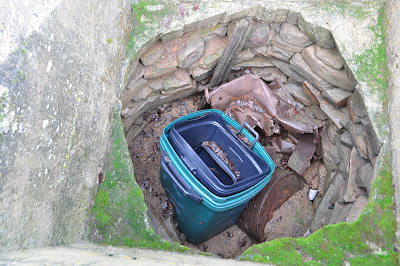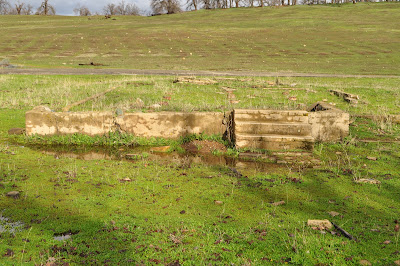Above: the town of Piety Hill, date unknown. From the collection of Jeremy Tuggle.
Piety Hill is a fine example of a present-day ghost town, which was located in western Shasta County, California. This town was located about a quarter mile east of the present-day town of Igo, on what is now Cloverdale Road, and northward for 0.7 miles, however, the majority of these historic relics from this community is situated on private property which most of them are viewable by-passing motorists from the roadside. Piety Hill was established in 1849 as a gold mining camp and it eventually boasted of 1,500 residents including 600 Chinese settlers nearby due to the local mining claims in the area producing gold. The Chinese mined and worked their vegetable gardens here, there was no China town at Piety Hill.
In 1853, the lucrative Hardscrabble mine began its production of lucrative minerals by the Dry Creek Tunnel and Fluming Company, which began the construction of a water ditch by Chinese labor that is seen in this YouTube video
here. It became a 22-mile-long water ditch which diverted water from the North Fork of Cottonwood Creek, Eagle Creek, Andrews Creek and the South Fork of Clear Creek. Then in 1857, gold pans yielded miners working their mining claims at Piety Hill from $60 to $190 per pan. At that time, the community was home to a few families in the area with children when they organized a school at that place and erected a schoolhouse. It was a booming up-and-coming place to live. In 1858, a man named Eugene Crowell kept a general merchandise store at Piety Hill which was a very successful business venture for him due to the production of gold from the local mining claims.
There are two stories of how Piety Hill received its name. Both are quite interesting and easy to believe. One account is that a family named McKinney moved into the area, having come from Piety Hill, Michigan, and the family members named their new home after their former hometown. Another explanation suggested by some historians is that this mining camp was occupied by religious groups which chose to name the community Piety Hill. Piety Hill does appear on the first official map of Shasta County which was surveyed by Colonel William Magee in February of 1862.
The present-day town of Igo began as the relocated community of Piety Hill. Residents moved in 1866, probably to segregate themselves from Chinese miners who were settling in Piety Hill, but also because people learned there was an ancient river channel under the community, making it reliable for well digging. George McPherson was the superintendent of the lucrative Hardscrabble mine as well. It was their hydraulic mining methods which also played a part in declining Piety Hill's growth while the nearby town of Igo burgeoned with success.
In 1867, my paternal great-great-great grandfather the Reverend William Samuel Kidder, a pioneer Baptist minister, school teacher, farmer and miner, among other things, was recorded as living at Piety Hill, that year, after relocating his wife and children from French Gulch. His registration is found in the California, U.S., Voter Registers, 1866-1898. His occupation at that time was a post master but Piety Hill lacked a United States Post Office to send and receive mail which this notation meant that Kidder was employed as post master for the French Gulch United States Post Office. My ancestors eventually relocated from Piety Hill to Eagle Creek (now Ono) at a later date.
By 1868, it was generally thought that the local mines in the area of Piety Hill were worked-out but that wasn't the case. McPherson and his men at the Hardscrabble mine cleaned up from its tailings or dump pile several thousand dollars from gold which was the largest assessment of gold ever produced at that location. That year also witnessed the erection of a brand-new sawmill in the area by Petty & Company, yet this lumber mill was a short-lived business venture.
A year later, Shasta County resident Charles McDonald, a well-known stage proprietor operated an express called McDonald's Express which took passengers from Shasta amongst the following western Shasta County communities: Middletown, Centerville, Piety Hill, Horsetown, Janesville (now Gas Point), and Roaring River. Roaring River was the farthest southwest which this stage line traveled to at that time. Later on, in 1870, Alamarin W. Baker, a resident of Eagle Creek (now Ono) operated a stage line called Baker's Shasta & Red Bluff Express which took passengers from Shasta to Red Bluff (in Tehama County), while making stops in between at Piety Hill and Horsetown.
Even though Piety Hill appeared to be in a declining state the local schoolhouse in May of 1871, had forty-one students enrolled into their one-room schoolhouse. The teacher at that time was Joanna T. Casey. While locals were still prospecting the area for new prospects other mining claims were still being patented in the region into the 1880s and 1890s, and by the turn of the twentieth century, Piety Hill suffered quite a loss from local mines failing at their production of ore while very few residents remained at Piety Hill.
In 1915, the Hardscrabble mine at Piety Hill was worked by miners mining away in drifts and toiling away in shafts on the property while utilizing hydraulic mining methods as a source to extract the gold from this mine, which was located in Section 27, 34 and 35, Township 31 North, Range 6 West, 1/2 mile south of Igo, and consisting of 1,700-acres, of patented mineral land. The owners were the Happy Valley Land and Water Company of Olinda. A. E. Bowles was the president of this company. This company owned the old Dry Creek Tunnel and Fluming Company's water ditch, which was then known as the Happy Valley water ditch as seen in the above YouTube video.
Remaining points of interest from Piety Hill include a reservoir, the Dry Creek Tunnel and Fluming Company's water ditch, also known as the Happy Valley water ditch, pieces of structures and depressions in the ground which were from the cellars below the Chinese buildings. Look for these historical relics along Cloverdale Road the next time you drive by in your vehicle. You might be amazed at their existence. The death knell of this community which never established a United States Post Office to send and receive mail came in 1920 when the last two residents of Piety Hill died.
Resources:
Condition of Our Public Schools - The Shasta Courier newspaper of Shasta, January 30, 1858
To Miners - The Shasta Courier newspaper of Shasta, April 3, 1858
S. Of T. - The Shasta Courier newspaper of Shasta, October 23, 1858
Mining Improvement - The Sacramento Daily Union newspaper of Sacramento, May 21, 1861
California, U.S., Voter Registers, 1866-1898
Enterprising - The Shasta Courier newspaper of Shasta, January 25, 1868
Letter From Piety Hill - The Shasta Courier newspaper of Shasta, June 6, 1868
School Report - The Shasta Courier newspaper of Shasta, May 20, 1871
Notice of Application for Patent To Mining Claim - The Shasta Courier newspaper of Shasta, October 4, 1873
Big Interest in Shasta Are Sold - The Sacramento Daily Union newspaper of Sacramento, July 21, 1911
Happy Valley to Be Transferred - The Sacramento Daily Union newspaper of Sacramento, July 30, 1911
U.S., Appointments of U.S. Postmasters, 1832-1971
REPORT XIV OF THE STATE MINERALOGIST - MINES AND MINERAL RESOURCES OF CALIFORNIA - CHAPTERS OF STATE MINERALOGIST’S REPORT BIENNIAL PERIOD, 1913-1914. CALIFORNIA STATE MINING BUREAU, CALIFORNIA STATE PRINTING OFFICE, SACRAMENTO.
Mines and Mineral Resources of Shasta County, Siskiyou County, and Trinity County, by G. Chester Brown, ©1915 published by California State Printing Office.
My Playhouse Was a Concord Coach, an anthology of newspaper clippings and documents relating to those who made California history during the years 1822-1888, by Mae Hélène Bacon Boggs. Published by Howell-North Press ©1942
Shasta County, California A History by Rosena Giles, published by Biobooks, ©1949.
Way Back When - Myrtle McNamar, published by C.A.T. Publishing of Redding, California, 1952. 282 pages.
The Story of Western Shasta written by R.S. Ballou, The Covered Wagon, 1964, published annually by the Shasta Historical Society
Place Names of Shasta County by Gertrude A. Steger revision by Helen Hinckley Jones, ©1966 by La Siesta Press, Glendale, California
Mines and Mineral Resources of Shasta County, California – County Report 6 – by Philip A. Lydon and J.C. O’ Brien ©1974 by California Division of Mines and Geology












